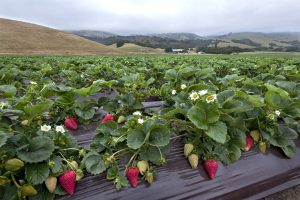California strawberry production continues to progress despite many areas of the community slowing down in response to the COVID-19 pandemic. Agriculture has been deemed an essential industry, allowing workers to continue with production. Growers will remain busy as fruits and vegetables continue to be in high demand in grocery stores.
“What we’re hearing from both growers and shippers, as well as just what the USDA is reporting, is demand is very strong,” said Carolyn O’Donnell, Communications Director for the California Strawberry Commission. “It’s good to see that the American public has decided that they really want to stay healthy and are eating fruits and vegetables, so it’s nice to see that demand is good. Growers seem to be happy with the price right now too.”
Most of the current California strawberry production is currently taking place in southern California, with producers preparing for peak season which is expected to come in late April or early May. The industry makes tremendous effort to ensure the safety of crops as well as the workforce, which have been amplified even further to prevent the risk of exposure to coronavirus.
“During a ‘normal’ year – without the additional challenges – we do have a fairly extensive food safety training program,” O’Donnell explained. “We’ve really shifted some of the focus more heavily on staying healthy at work and handwashing and proper handwashing and sanitation in the field. So, we’ve emphasized that more in our trainings and then we’ve developed a few extra materials to be used out in the field to act as reminders.”
Growers is many areas are watching the weather forecast closely, with snow levels currently at approximately 50 percent of average for this year. While there is hope that the year will end up as a solid water year, the strawberry industry has already made great strides in reducing their water use over the years. “The great news about strawberries is they do use drip irrigation; they’ve been using that for decades. So that really does help to conserve the water usage for the crop,” O’Donnell noted.
Listen to the interview below.











